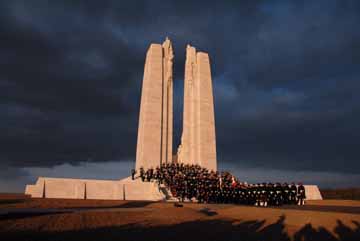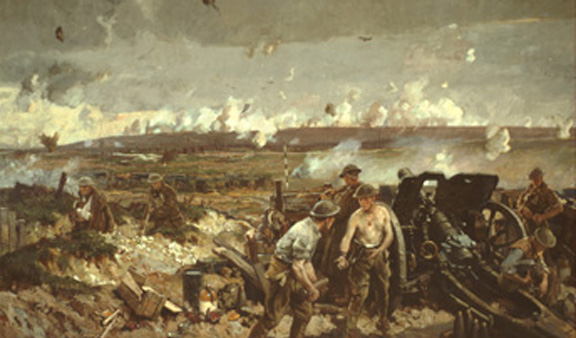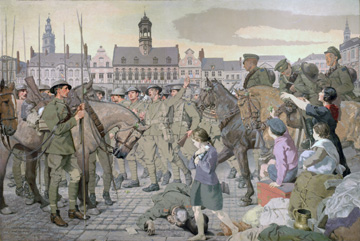 This information has been archived for reference or research purposes.
This information has been archived for reference or research purposes.
Archived Content
Information identified as archived on the Web is for reference, research or recordkeeping purposes. It has not been altered or updated after the date of archiving. Web pages that are archived on the Web are not subject to the Government of Canada Web Standards. As per the Communications Policy of the Government of Canada, you can request alternate formats on the "Contact Us" page.
Views and Opinions

DND Photo SU 2007-0156-07 by Master Corporal Jill Cooper
Vimy Ridge, 7 April 2007.
The Use and Abuse of Battle: Vimy Ridge and the Great War over the History of the First World War
by Major John R. Grodzinski, CD, MA
For more information on accessing this file, please visit our help page.
The war of 1914-1918 that swept mankind into the most horrific struggle it had yet experienced ended 91 years ago this November. While the events of so many years past may appear to be of little concern today, the struggle to explain what happened during this conflict continues as historians weigh the evidence as to the causes of the war. While in general terms there is not much new to learn about the war, there is lively debate with respect to strategy and tactics in the Allied camp, as well as increased study of the Imperial effort, including the story of the Canadian Corps.
The ‘master narrative’ is that war erupted in Europe during the summer of 1914 with everyone believing the troops would be home by Christmas. Within a few weeks, a series of open, pitched battles gave way to a static, bloody war dominated by trenches, wire, endless artillery barrages, and carnage, with little tactical let alone operational or strategic level successes. During the 1920s and 1930s, the cause of the slaughter was eventually attributed to the incompetence of senior military commanders, indifferent to the soldier’s fate and ignorant of their profession. The only bright light to emerge from this mess was from the Imperial contingents, troops from Australia, Canada, India, and New Zealand, who, perhaps through their own ignorance of things doctrinal, found innovative ways to overcome the malaise of the Western Front, leaving their British brethren behind. Perhaps the best-known example of this narrative is Vimy Ridge, where the Canadian Corps demonstrated superior martial skills by taking a feature that had eluded both the French and British armies, and, in doing so, somehow gave birth to a national identity. Canada had become better than Britain at this game…
Or so the story goes, but the historical evidence paints a different war, one that has proven difficult to imprint over the established popular historiography. As the distinguished British historian Richard Holmes has observed, breaking popular notions is difficult, even when given strong evidence to the contrary. We find comfort in the “master narrative.” Why is this so?

Richard Jack, The Taking of Vimy Ridge, Easter Monday 1917, CWM 19710261-0160, Beaverbrook Collection of War Art, ©Canadian War Museum
Our understanding of the Great War was developed from several sources. Veterans provided the first stories through letters and anecdotes, but as few committed their experience to paper, most of these perspectives were lost within a couple of generations. A more powerful builder of historic memory was embodied in the first books and memoirs that appeared in the immediate post-war years. David Lloyd George, the British Prime Minister throughout most of the war, attributed blame to the generals, who repeatedly ‘cocked up’ the clever plans developed by the politicians. Winston Churchill’s multi-volume history of the Great War reinforced this perspective. Churchill also had his own political skeletons to hide, particularly with respect to his role in the ill-fated Dardanelles expedition of 1915 and 1916, and he used his eloquent and convincing prose to conveniently lay the blame elsewhere.1
Thus, self-justification built and then reinforced a mythology of continued military incompetence that gained further credence with the publication of a handful of soldiers’ and junior officers’ memoirs. While one cannot dismiss what they personally faced on the front line, they were not privy to the workings of higher command. Thus, accusation and acrimony laid the groundwork of blame. Such was the case in Canada, where the same few repeatedly-quoted memoirs framed our understanding of the war. The supposed superiority of the Dominion contingents was then cemented by a brief passage in the British Official History2 of the Great War that suggested the homogeneity of the Australian and Canadian corps was the reason for their outstanding performance. This, in turn, launched a series of partisan books building upon that claim without ever investigating its validity, and also, by attributing innovations made by British officers to Canadians.
By the mid-1930s, it was commonly held that the war had consisted of a series of disastrous rushes ‘over the top’ while the generals enjoyed a happy and ignorant existence in châteaux far behind the lines. Accounts were twisted to reinforce these ideas, including the infamous distortion of the remarks made by General Kiggell, Haig’s chief of staff, during Passchendaele, when upon visiting the line, he exclaimed: “Good God did we really send our men to fight in this?” suggesting total ignorance of the conditions at the front. Historians then lined up to vilify British general officers and their staffs by using phases such as “butchers and bunglers” or Alan Clark’s famous 1961 assertion that the British army of the Great War consisted of “lions led by donkeys” that became a popular description of the relationship between soldiers and their generals, and was then used in plays, films, poetry, and still more books.3 Once ideas like this are planted, they are difficult to change.
Britain today enjoys a lively scholarship on the Great War that is perhaps more honest and soul-searching than that being conducted in Canada.4 Recent British studies have clearly demonstrated that flexibility, innovation, and leadership were not characteristics solely demonstrated by Canadian or Australian corps commanders, but were evident also in most of the 47 British corps in the line. Indeed, during the course of the war, these corps commanders changed the role of the corps headquarters from being ‘a post box’ for relaying orders, to having an important role in planning and executing operations. Indeed, by 1918, the corps was the key fighting formation.5
We also have a better understanding of British generals. Few came from the aristocracy.6 Some may indeed have been pompous or stupid, such men and women can be found today in all armies, but they were not generally remote. The majority came from the middle class, and most were professional soldiers, while a handful came from civilian occupations. They also shared in the dangers, 78 of whom were killed in action, and another 120 wounded or taken prisoner, a far higher number than occurred during the Second World War.7 As a group, these officers sought to derive lessons, to develop and implement new tactics and procedures, and they established a combined arms doctrine that could deliver the infantry to their objectives and secure victory.8 The ‘rub’ in getting there lay in effecting change in an army composed of millions of men during a time of war, a daunting task at which few would likely succeed, let alone want to attempt. I have enough trouble trying to change some routine in my family of five…
Unfortunately, most of us will not be exposed to these important studies, as they are produced by academe or by competent amateur historians – works that are dismissed by journalists as dry, unreadable, and overly academic. Preference is given to lively narratives that offer exciting stories, often based upon earlier published works. While history is indeed exciting, it is also hard work, pinning down detail and examining complicated matters, such as corps-level artillery fire coordination, the form of platoon attacks, or the sinews of logistics. Popular writers might offer lots of colour, but they do not have the time, or, frequently, the inclination, to master detail. Perhaps this why most well-known Canadian ‘historians’ are actually journalists, and not those trained and tested in the field of historical research and study.
Our understanding of the Great War has not been served by vigorous study and debate. Indeed, our historiography is relatively immature, and it has progressed little beyond narrative studies and nationalist propaganda, although a group of young scholars (OK, a few grey-haired ones as well) are changing that. Until these studies are more widely read, we are left to rely upon literature that is of mixed quality, including Pierre Berton’s execrable (a wonderful onomatopoetic motivation) Vimy Ridge that has distorted this battle beyond anyone’s ability to repair the damage.9 The Canadian Corps was a marvellous field formation, and it performed brilliantly during the Battle of the Scarpe. The Canadians did take Vimy Ridge and advanced beyond, while neighbouring British corps achieved similar, and, in some cases, even more spectacular success, but what were the results? These achievements did not mark a ‘turning point’ in the war, as Passchendaele and the German Spring Offensive of 1918 demonstrated. It did not establish Canadian nationhood – that came through a sense of confidence developed during the entirety of the war itself, where a self-governing colony gave much of itself to a cause, and, in the process, changed. The notion of soldiers coming down Vimy Ridge as Canadians was not expressed in 1917, but it was fabricated by a series of leading questions directed to Great War veterans during the 1960s.
Some 10,000 Canadians became casualties at Vimy, including nearly 3600 killed in action, losses seemingly less appalling than the Somme, but then war is a fickle thing where victory is often as costly as a defeat. In the case of Vimy, losses were proportionally the same as several of the worst battles of the war, but this was not a sustained offensive. Had it been, our perspective of that battle might well be different. Furthermore, comparing Canadian success in 1917 with British or French tactical performance around Vimy in 1915 or early 1916 is unfair, given the sweeping innovations that occurred and that were employed by the British corps fighting alongside the Canadians at the Battle of the Scarpe. The rush to praise our achievements comes at the cost of forgetting the achievements of those who instituted these changes.
So far so good, but, given such losses, how can one suggest anything went ‘well’ and argue that the leadership was ‘good’ or ‘successful’? The attrition of 1915, 1916, and 1917 gave way to the renewal of open battle in 1918, when the allies achieved unprecedented success using many weapons, tactics, and procedures that had not existed four years earlier. They also prepared their field armies for the shift from defensive, trench warfare to fighting in the open and in a variety of complex terrain. The price in achieving this was dear, and, once the tactical malaise was broken, heavy losses still resulted.10 Success was achieved, not by ‘donkeys,’ but by a hard-working leadership determined to overcome the stalemate of the trenches. We owe it to those who fell to come to grips with what happened. This demands hard work and study, discussion and debate, rather than the simplistic popular accounts that plague military history. Otherwise, we are truly leading ourselves down a very dangerous road. History is a living thing, as is our understanding of historical events. It is a process of accretion; one author takes our understanding to a point, before others advance it even further. We must understand how perspectives have evolved, and encourage new and original research, free of nationalistic ‘baggage,’ in order to gain a better appreciation of what actually happened. In that way, we will find some of the answers we are looking for that may help guide on the challenges ahead.

Inglis Sheldon-Williams, The Return to Mons, CWM 19710261-0813, Beaverbrook Collection of War Art, ©Canadian War Museum
![]()
Major Grodzinski, an armoured officer, teaches history at the Royal Military College of Canada, where he is also a doctoral candidate.
Notes
- Churchill’s capacity to bend history to suit his views is well covered in David Reynolds, In Command of History: Churchill Fighting and Writing the Second World War.(London: Allan Lane, 2004).
- A fascinating discussion of the challenges of ‘official’ history is presented in Andrew Green, Writing the Great War: Sir James Edmonds and the Official Histories, 1915 – 1948(London: Frank Cass, 2003). It is interesting to note that it took British historians 33 years to write their official history of the war, while most other countries achieved this in a far shorter period. The Canadian official history only appeared in 1962.
- A discussion of the historiography of this subject appears in Chapter 7 of Gordon Corrigan, Mud, Blood and Poppycock: Britain and the First World War. (London: Cassell, 2003).
- The recent anniversaries of events in 1917 and 1918 have fuelled this debate and led to a series of new titles, or re-examinations of previous works. Nowhere is the debate more passionate than in assessing the performance of Field Marshal Sir Douglas Haig, commander of the British Expeditionary Force from 1915 until the end of the war. See Denis Winter, Haig’s Command: A Reassessment. (London: Penguin, 1991), and the introduction of Gary Sheffield and Jon Bourne (eds.), Douglas Haig: War Diaries and Letters, 1914 – 1918. (London: Weidenfield & Nicolson, 2005).
- The only book to examine this topic is Andy Simpson, Directing Operations: British Corps Command on the Western Front, 1914 – 1918. (Stroud, UK: Spellmount, 2006).
- It is interesting to note that the total number of families that fell under the peerage during the period totaled 685, and from these families, some 1500 men served in the army or other services. Of these, 270 were killed or died as a result of the war. See Gerald Gliddon, The Aristocracy and the Great War. (Norwich, UK: Glidden Books, 2002).
- See Frank Davies and Graham Maddocks, Bloody Red Tabs: General Officer Casualties of the Great War, 1914 – 1918. (London: Leo Cooper, 1995).
- Not surprisingly, several important topics, including logistics, an area modern ‘professional’ soldiers continue to ignore, have received little study. A good examination of the pre-war staff college training and wartime challenges appears in Ian Malcolm Brown, British Logistics on the Western Front, 1914 – 1918. Westport, CT: Praeger, 1998).
- The best book on this battle remains Geoffrey Hayes, Andrew Iarocci and Mike Bechthold, (eds.) Vimy Ridge: A Canadian Reassessment. (Waterloo. ON: Laurier Centre for Military Strategic and Disarmament Studies, 2007), while several British studies of the battle surpass the popular works of Berton and Ted Barris.
- Even during the celebrated advance from 8 August to 11 November 1918, the Canadian Corps suffered 42,628 casualties, or 20 percent of the entire losses suffered by the Corps between 1915 and 1918.






